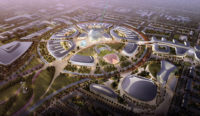
The goal of the “decarbonization” plan is to improve the performance of buildings and infrastructure systems in the Chicago Loop.
A Chicago architecture firm is producing a holistic planning approach to reduce carbon emissions in dense urban cores.
The fledgling urban planning effort, which Adrian Smith + Gordon Gill Architecture is developing for the 550-building Chicago Loop area, is a process that starts with a survey of existing buildings in a district to assess age, use, condition, energy consumption, and more. The survey is a first step toward devising a district-wide approach to sustainable retrofits and appropriate adaptive reuse. The planning framework can be used as a model for retrofits in other cities, says the architect.
The firm outlined its plan at the Council on Tall Buildings and Urban Habitat (CTBUH) 2009 conference. The event, dubbed “Evolution of the Skyscraper: New Challenges in a World of Global Warming and Recession,” was held October 22 to 23 in Chicago and drew 613 people from 35 nations.
Adrian Smith, FAIA, says the goal of his firm’s Chicago Central Area Decarbonization Plan is to improve the performance of every building and major infrastructure system within Chicago’s Loop. The idea is to reduce the area’s emissions of 3.9 million metric tons of carbon per year, to meet the goals of the 2030 Challenge.
The firm is still building its database, having surveyed 550 Loop buildings and interviewed 24 of 83 building managers. This is the start of a “monumental effort,” said Smith. His firm is sponsoring the study with its own funds and with cooperation from the city and local organizations.
Antony Wood, CTBUH’s executive director, expressed support for the plan. “If we want to make the biggest difference to the planet tomorrow, in terms of lessening the impact of building operations on climate change,” he says, “then we need to concentrate on the upgrade of existing buildings.”



